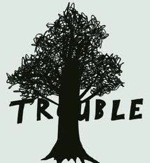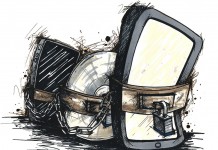 I could say “The Trouble with Scientific American”, which is where the article appears, because you have to have a subscription to read the whole thing.
I could say “The Trouble with Scientific American”, which is where the article appears, because you have to have a subscription to read the whole thing.
Here’s a snippet from the part that I can see:
The biggest problem of all, though, is the e-books themselves. The publishers insist that e-books must be copy-protected. Predictably, each company uses a different protection scheme. You can’t read a Kindle book on a Barnes & Noble Nook or a Sony Reader book on an iPad.
You can still read a 200-year-old printed book. But the odds of being able to read one of today’s e-books in 200 years, or even 20, is practically zero.
No, you won’t be giving a well-worn e-book to your children. But you won’t be giving one to your friend, either; you can’t resell or even give away an e-book. It doesn’t seem right. Why shouldn’t you be able to pass along an e-book just the way you’d pass on a physical one? You paid for it, haven’t you?


































Paul – I believe that the full article is actually visible on that link.
Pogue also writes:
“Second, when these tech changes do occur, they tend not to wipe out the existing technologies; instead they just add on. Television didn’t kill radio as everyone expected. E-mail didn’t wipe out paper mail, either; the paperless office may never arrive. For the same reason, e-books won’t kill paper books.”
Well, not quite. CDs did more than kick sand in the face of LPs; it decimated the format. Then mp3 finished it off … and smacked CDs around, probably lethally.
Tech changes do, in fact, wipe out existing technologies some of the time and ebooks is going to beat up print books in a large way. Paper books rely on bricks and mortar distribution: ebooks will kill bookstores in the same was as On Demand and Internet video is killing the video store and the format it sponsors — DVD/Blu-ray.
Without bricks and mortar book stores, where do you purchase coffee table books in the holiday season? Home Depot? Or if you’re looking for the latest popular fiction mass paperback, when Borders is no more, it’s back to the drug store. If Walgreen’s becomes a core part of paperback distribution, look out.
ebooks have not won this battle … yet. It’s hard to look out five years from now and imagine paper with an 80% share.
Except that there’s still a thriving enthusiast market in vinyl. Maybe it’s not a mass-market format anymore, but it’s far from dead.
And even the cassette isn’t entirely dead even in the digital age. Sony only just stopped making the cassette walkman a few weeks ago.
Even if e-books gain an 80% market share, paper books will still be around. And 20% is far from dead—look at how much we’re talking about e-books already and they’ve only got a 5% market share so far.
Not for me.
The article looked complete to me, too.
There was only one sentence visible on the second page, but it seemed like a closing sentence to me. I believe it is probably a victim of some word-count algorithm that chops the first page off at a specific point, regardless of how much more article remains.
And I likewise suspect that the presence of only one sentence on that page, followed by a “subscribe!” boilerplate, may have led Paul to believe that there would have been more if one was subscribed to the magazine. I doubt this is the case.
Sorry about that Paul. I have checked it in Opera, Firefox, Chrome and Safari on my Mac and it is fully viewable on all of them.
Well Chris I would ask what the word ‘dead’ in this context is intended to mean 🙂
I would suggest that Vinyl is effectively dead … no ? 🙂 Also Cassettes. The fact that there is a market for previously issued product and a tiny residual number of new albums on sale does not really mean it is an active way of distributing content ? Does it have to disappear completely off the face of the earth ? 🙂
With Books I agree with you – in this case paper books are far more than a distribution medium. They are an iconic and cultural object. As such I doubt that they will not drop below 20% for at least 25 years and will remain an active, produced product for the rest of the century.
Print does need to shed large sectors of extraneous genres that were once without alternative delivery formats. We once printed airline schedule compilations in paper. I have heard 10% to 20% as the sector allocated to cohesive scholarly and creative works of enduring relevance that will continue in paper print. Other smaller genres such as self-published color pictorials are still emerging in paper print as well.
So the paper book has some refocus going on to best allocate the physical book format to the transmission types that suit it best. Screen books will also go through such optimizations. In later interplay of paper and screen books we should see each growing within their own healthy markets and logical functions
@Howard: “With Books I agree with you – in this case paper books are far more than a distribution medium. They are an iconic and cultural object. ”
Yeah. So are vinyl records.